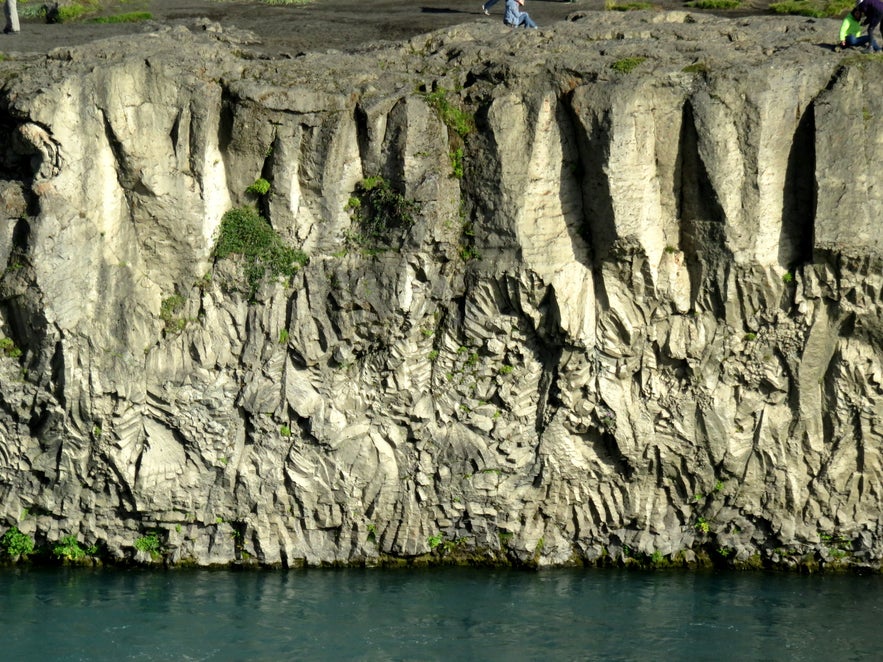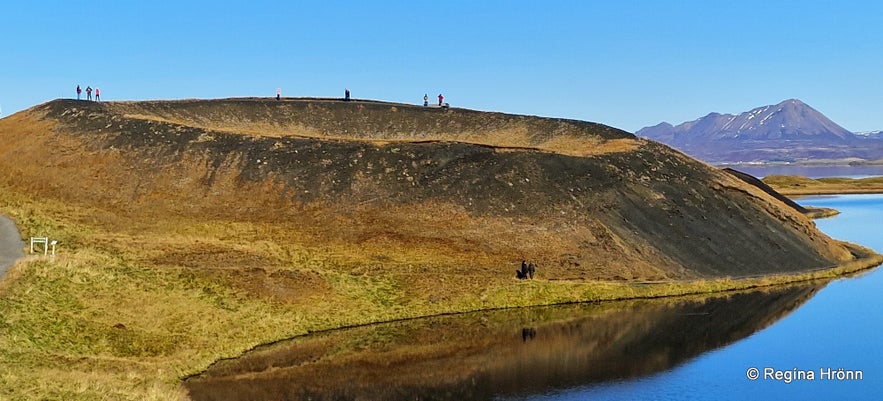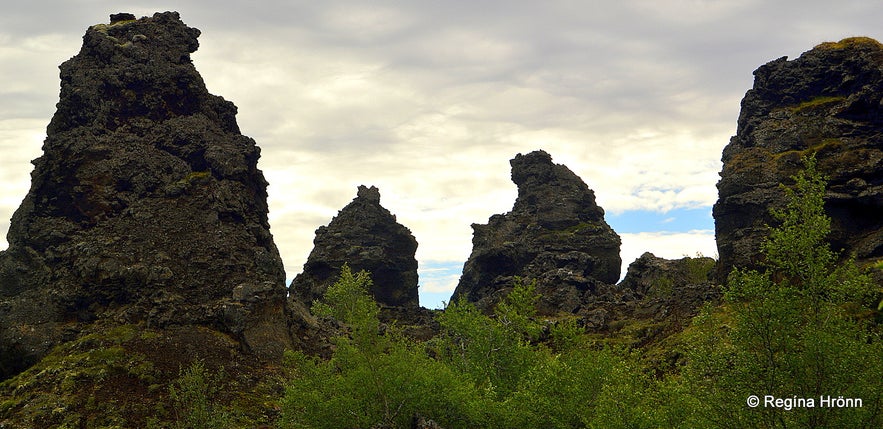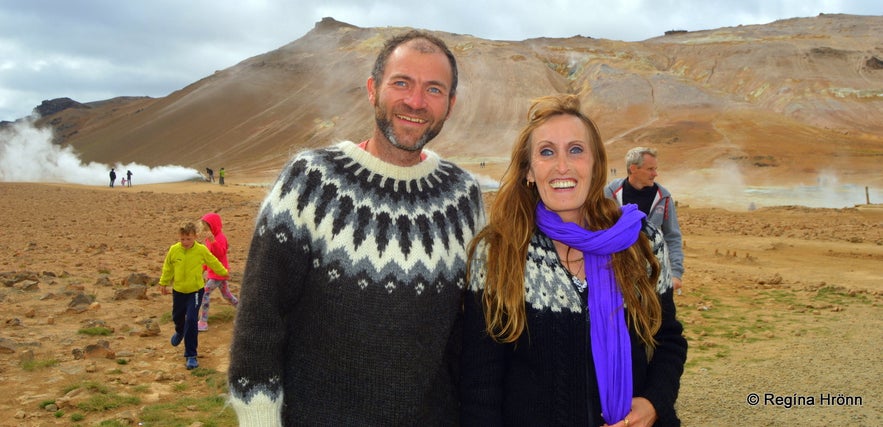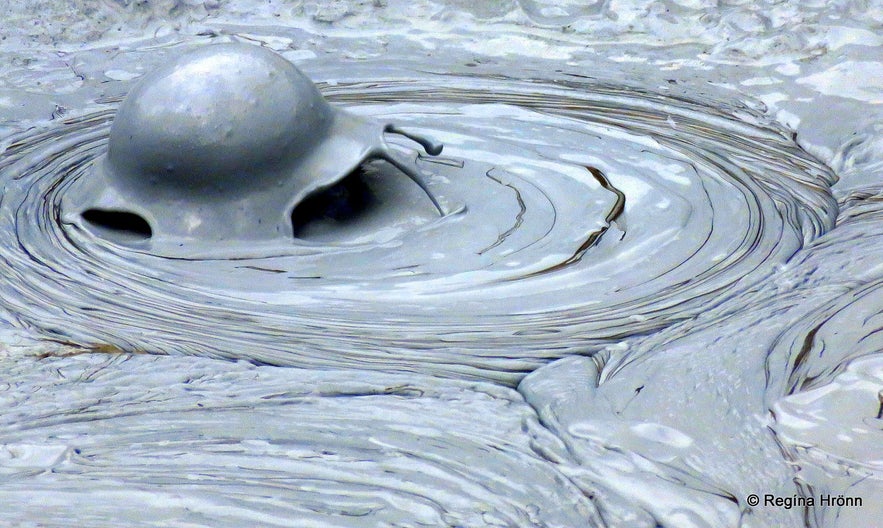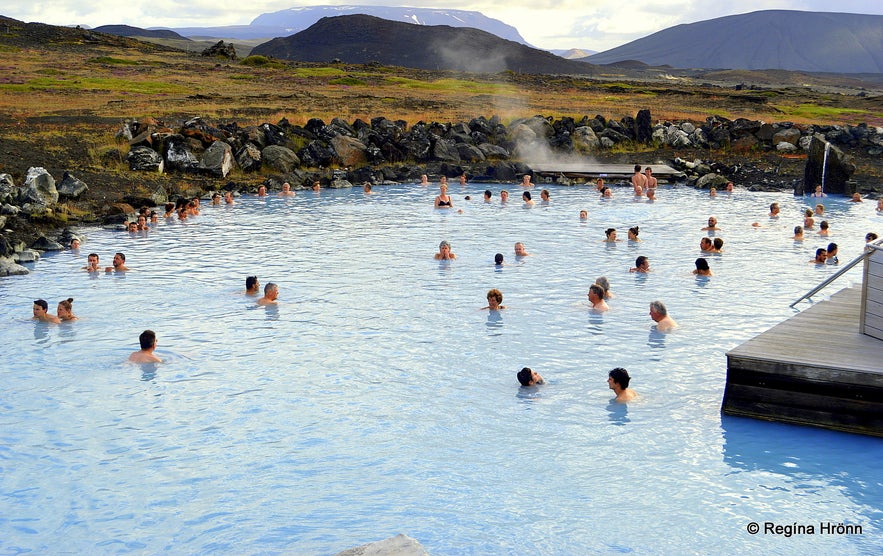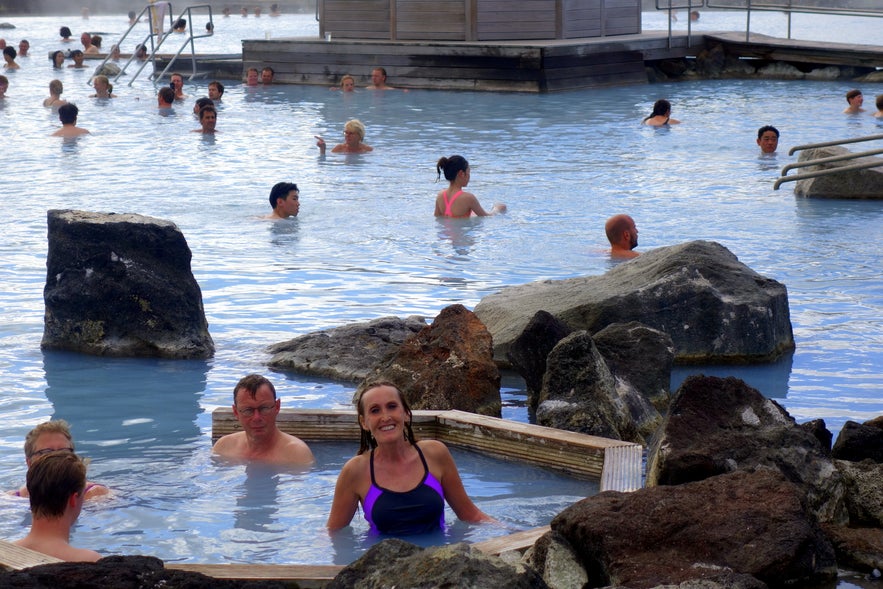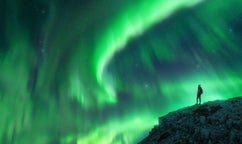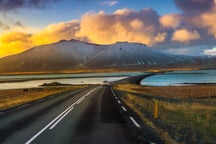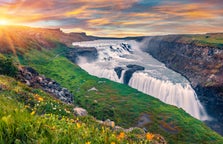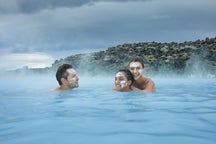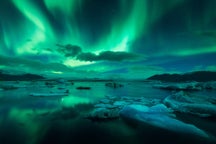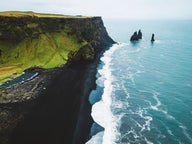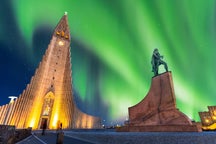
I have written many travel-blogs about the extraordinarily diverse Mývatn area in North Iceland through the years.
Now I want to show you a guided tour of Mývatn, as it is always very informative to listen to the geological explanations from the guides and learn new things about Iceland.
I was staying with a friend for a week in Akureyri and decided to try out as many tours as I could in this area to introduce them to you.
I was picked up very early in Akureyri, the capital city of North Iceland, and the guide made the first stop at an observational platform on the other side of Eyjafjörður fjord where we had a beautiful view of Akureyri town.
Top photo: Akureyri - the Capital of the North
Goðafoss - the Waterfall of the Gods
Goðafoss - the Waterfall of the Gods
Our second stop was by Goðafoss waterfall, which is a beautiful and historical waterfall, right by the main road.
The name, Goðafoss, means the Waterfall of the Gods. There is a story behind it dating back to the year 1000.
The conversion to Christianity in Iceland was made in that year and the Lawspeaker and ex-Pagan Chieftain, Þorgeir ljósvetningagoði, is said to have thrown his idols of the old pagan Nordic gods into this waterfall - right after returning from the Alþingi Parliament at Þingvellir where the conversion was made.
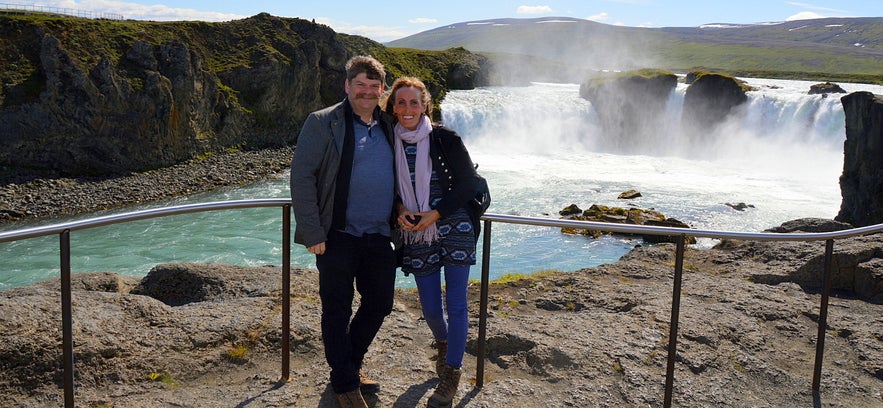 A photo taken from the west bank
A photo taken from the west bank
I always think about this Viking story when I visit this beautiful waterfall.
On this tour, we visited both the east bank and the west bank. There is a new viewing platform on the east bank where you can admire the waterfall.
Also on the east bank, you will be able to see the beautiful artwork of nature on the west bank - see my photo below.
Beautiful basalt columns by Goðafoss
This historical waterfall, which has a drop of 12 meters and a width of 30 meters, cascades into the white and green glacial river Skjálfandafljót.
Skútustaðagígar - Pseudocraters
Skútustaðagígar pseudocraters
After visiting Goðafoss waterfall we entered the Mývatn area, where the first sight of interest is Skútustaðir pseudocraters.
We made our third stop here and walked on the rim of the pseudocraters from where there is a lovely view of Lake Mývatn.
This natural phenomenon is formed when lava flows over wet ground and pushes the ground down. This causes steam to be trapped under the weight of the lava which in turn causes a lot of pressure.

Skútustaðagígar pseudocraters
When the pressure becomes too great it causes steam explosions and the formation of these strange-looking pseudocraters.
As far as I know then this phenomenon can only be seen above ground here in Iceland and on the planet Mars.
Lake Mývatn
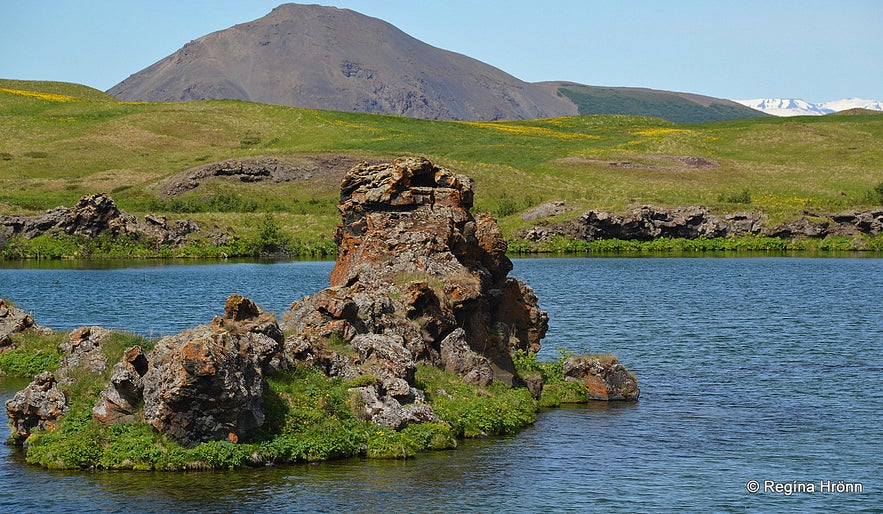
Lava pillars by Lake Mývatn
We made our fourth stop by Lake Mývatn, which was created in a basaltic lava eruption 2,300 years ago. There are so many freestanding lava formations in this area, including the lava pillars by and in Lake Mývatn.
Lake Mývatn is 37 km2 and there are some 50 islands and scerries on the lake. The lake is protected as a nature reserve as there is a very diverse water birdlife here, including 15 species of ducks that nest permanently at Lake Mývatn.

Birdlife on Lake Mývatn - horned grebe
Lake Mývatn gets its name from the myriad of midges in this area. They can be quite annoying, but they are the base of the ecosystem of Mývatn, so we have to endure them.
Our guide told us that twice during the summer huge black clouds can be seen - these clouds are the midges mating.
He told us that there can be from 750-900 tonnes of midges in this area! After their death, the midges enrich this area even further as then they become fertilizers.
Dimmuborgir - the Dark Fortress
Dimmuborgir at Mývatn
Dimmuborgir - the Dark Fortress - at Mývatn is a true wonder of nature - an extraordinary labyrinth of lava formations. Here we made our fifth stop.
The formation of these lava cliffs and pillars is caused by lava ponds - hot lava streamed over these ponds trapping the water underneath the lava.
Steam issued through a vent in the lava ponds and formed these pillars, which then remained standing after the crust around them had disappeared.

Our group by the gap in Dimmuborgir
Dimmuborgir is 1 km in diameter with several walking paths - our guide walked us through these extraordinary lava formations for 35 minutes and made several photo stops.
I love visiting this area - there is even a hidden cave here where the Icelandic Yule lads live!
Vogafjós restaurant and cowshed
One of my fellow travellers on the tour saying hi to the calves at Vogafjós
It was now time to have lunch so our sixth stop was made at Vogafjós restaurant.
Vogafjós restaurant is a bit out of the ordinary as Vogafjós means Cove Cowshed. From a window in the restaurant, one can actually have a look at the cows in the cowshed.
Or just pop in to visit the cowshed and have a look at the cows and their calves. They are very friendly and inquisitive.
I took so many photos of my fellow traveller stroking and talking to one of the calves, as it was so beautiful watching them together.
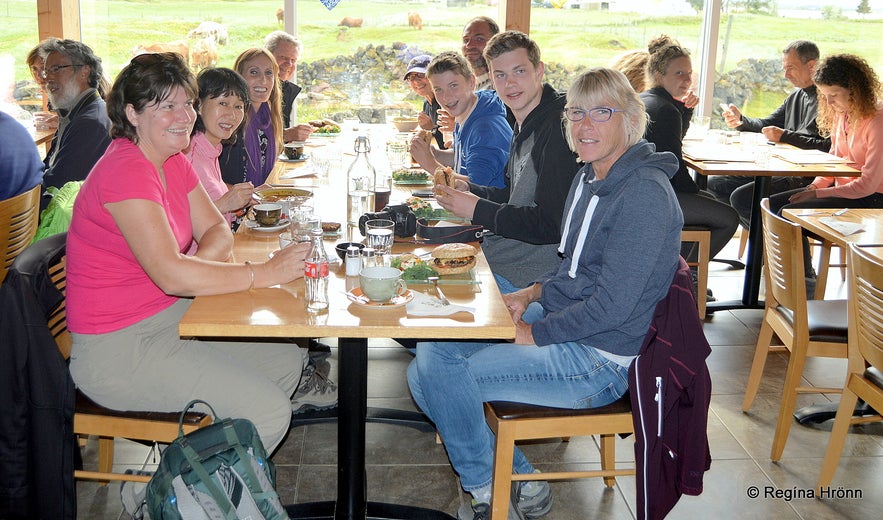
Having lunch with the group at Vogafjós
The farmers at the farm Vogar by Vogafjós smoke their own trout from Lake Mývatn and lamb in a turf shed on their land. And they make their own rye bread, which is cooked in hot springs in Mývatn.
The Mývatn mozzarella and salad cheese are made from the milk from the cows in the cowshed. They also make jam and tea from locally picked herbs.
On their menu is, of course, beef from their cattle. I love it when people put their pride in offering local food to visitors.
Grjótagjá Cave
Grjótagjá cave
We made our seventh stop not far from Dimmuborgir to check out Grjótagjá rift. Grjótagjá is a hot spring in a cave, with two entrances and a rocky path leading down to it. It is half-full with the most extraordinary blue geothermal water.
During the eruption of Mt. Krafla in 1975-1984, the temperature of the water rose so it couldn't be used for bathing for 20 years.
The temperature of the water is now again too hot for bathing. I dipped my feet in the water back in 2014 and it was very hot, something like 46 degrees C.
Grjótagjá is privately owned and belongs to the farmers at Vogar - bathing is forbidden here.
Mt. Námafjall and the boiling mud pools
With our guide at Hverir by Mt. Námafjall
We now headed out to Mt. Námafjall and the high-temperature area, Hverir. Our eighth stop was made by bubbling and boiling mud pools!
We had a very good guide from Belgium, Leo, who guided us in English but also spoke excellent Icelandic.
On our tour there was a Belgium family - I admire how Leo was able to switch from one language to another. Leo is in the photo with me above by Mt. Námafjall.
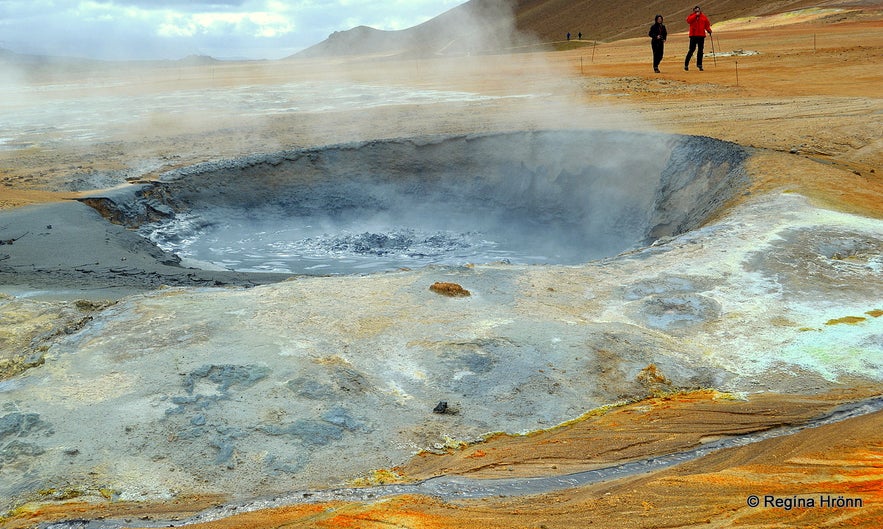
Boiling mud pots at Hverarönd
This area is referred to as the Hell's Kitchen due to the strong smell of sulfur in the air caused by the steam and the fumarole gas, such as hydrogen sulfide.
This gas can give you headaches and nausea if you stay in geothermal areas for too long or if it is very windy. It happened to me during one of my visits to Hverir and it took me 2 days to recover.
Boiling mud pots at Hverir
The hot springs also produce considerable sulfur deposits which were mined in Iceland in previous centuries to produce gunpowder.
The strange yellow, orange colour of this geothermal area stems from sulfur. You can see the yellow sulfur in my photo below.
Let's be extremely careful in this area as it is very hot and we do not want to see anybody get hurt or burned here. It is very important to stick to the paths in this geothermal area - and that goes for all of Iceland's geothermal areas.
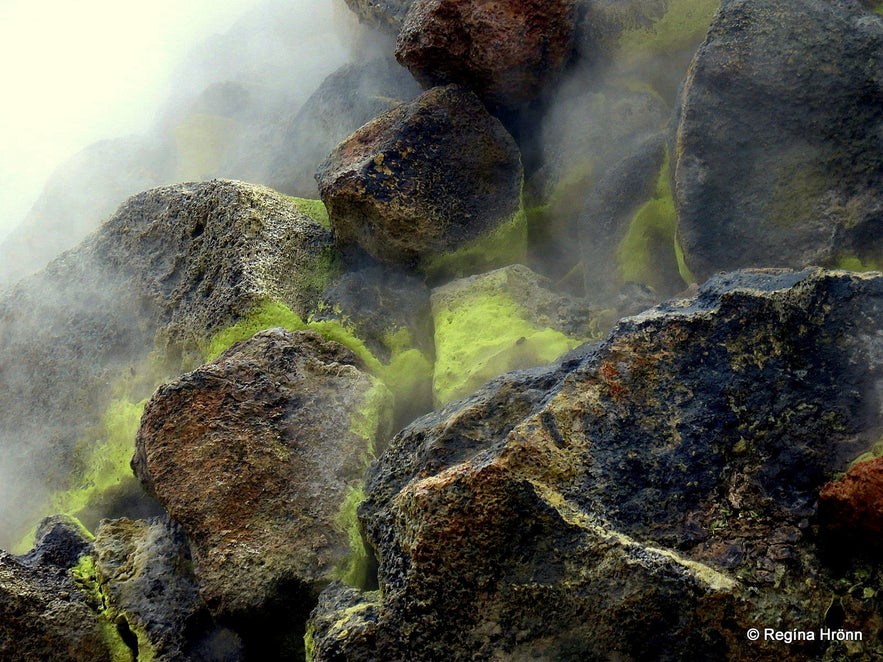
Steaming borholes at Hverir
I always get a knot in my stomach when I see footsteps inside the fenced-off geothermal areas!
We Icelanders are brought up to fear the dangers in Icelandic nature, so we know not to step inside fenced-off spots in geothermal areas.
Because if you step on mud inside these fences your foot might sink straight into a hidden boiling hot-spring and get severely burned.
This has happened on several occasions, so this is a real danger.
So my sincere plea, to those of you who don't know this, is: "Be careful out there"!
The Mývatn Nature Baths - the Blue Lagoon of the North
The Mývatn Nature Baths
By now it was 2:30 pm and time for some relaxation. Our ninth and final stop was at the Mývatn Nature Baths, where we soaked for 40 minutes.
The admission fee to the Nature Baths is included in the price of the tour, so the whole group dipped in.
I asked to be left behind when my fellow travellers left the Nature Baths and were driven back to Akureyri, as I was going to stay in our summer cottage at Mývatn for the night. My husband drove from Akureyri and picked me up later on.
I soaked by myself in this wonderfully blue geothermal water for 2 hours and the sun even came out, making this scenery even more beautiful.
Soaking in the Mývatn Nature Baths after the tour
The geothermal water in the Nature Baths, which cover an area of 5,000 m2, is drawn from depths of up to 2,500 meters and is rich in minerals, silicates, and geothermal microorganisms, which are believed to be beneficial for the skin.
The Mývatn Nature Baths are sometimes called the Blue Lagoon of the North. Soaking in the warm geothermal water is an excellent way to wind down after a day of visiting all the interesting sights in the Mývatn area.
This had been a truly wonderful day so I am glad I joined a day tour of Mývatn - I learnt a whole lot about this area and got to know some lovely people in the group.
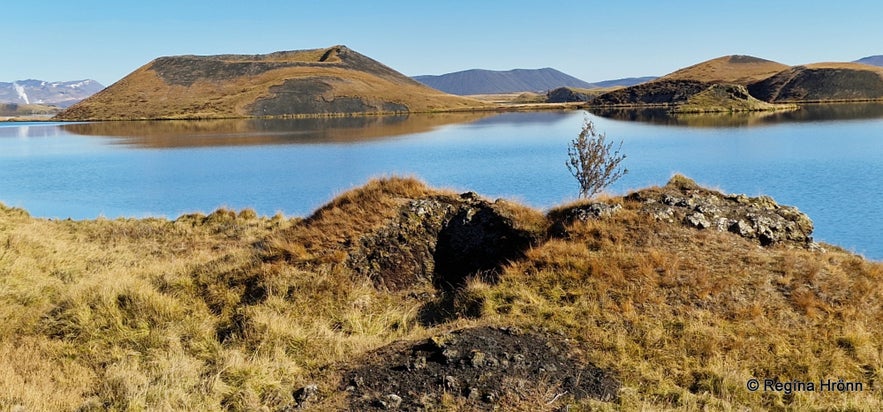 Lake Mývatn and Skútustaðagígar
Lake Mývatn and Skútustaðagígar
You can join this tour or similar tours, I highly recommend it to get to know this area better:
Fascinating 8-Hour Lake Myvatn Private Day Tour from Akureyri
Incredible 8-Hour Sightseeing Tour on Lake Myvatn and Godafoss Waterfall from Akureyri.
 At Hverir geothermal area
At Hverir geothermal area
I joined several other guided tours while travelling up north:
The Spectacular Diamond Circle in North-Iceland
A Unique Lava Walk through the colourful Lava Field Gjástykki at Krafla in North-Iceland
An Amazing Tour to Askja and Holuhraun Lava Field in the Highland of Iceland
A Wonderful Day of exploring the Mývatn Area in North Iceland
 Alone at Hverir geothermal area by Mt. Námafjall
Alone at Hverir geothermal area by Mt. Námafjall
Here you can see the location of Mývatn on Google Maps.
Here you can see the selection of Mývatn tours: The best Mývatn tours.
You can also check out the tours of Imagine Iceland Travel, they run a great selection of tours in this area.
Have a lovely time in North Iceland :)


